#Church of St. Nicholas in Kotor
Text
Lovcen National Park to Kotor
An epic walk from Lovcen National Park down 1,300m to the attractive old town of Kotor, tough on the knees, but a treat for the eyes looking out across the Bay of Kotor. To save a couple of hours of road walking I got a short lift from my hotel to a lookout with these stunning views.
It felt a little daunting descending to sea level from this altitude. There was a vague track across the open,…
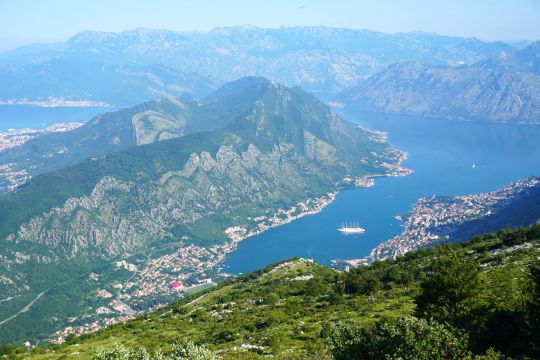
View On WordPress
#Crkva Svete Klare / Svetog Antuna#Kotor#Kotor Fort#Lovcen National Park. Nevjesta Jadrana#Montenegro#photography#Saint Nicholas Church#St Lukes Church#St. Tryphon&039;s Cathedral#Sveti Juraj#travel
0 notes
Text
Temples and monasteries of Montenegro - 20 main shrines
New Post has been published on https://tripsterguru.com/temples-and-monasteries-of-montenegro-20-main-shrines/
Temples and monasteries of Montenegro - 20 main shrines

Crystal clear Adriatic Sea, mountain landscape, picturesque valleys, comfortable climate make holidays in Montenegro popular for people of any age. There are no communication problems (minimal language barrier), the infrastructure of the resorts is well organized (relaxation is possible at any time of the year), and a huge number of architectural sights of the country are available for viewing. Among them, in the first place are the famous temples and monasteries of Montenegro, hidden in the thickets of luxurious greenery of rare plants, shrouded in an atmosphere of ancient legends, secrets of Montenegro.
Ostrog Monastery

An endless stream of tourists, pilgrims go to the main attractions of Montenegro. The cloister of the miracle worker Vasily Ostrozhsky is hidden in a rock at an altitude of 900 m above sea level (his relics are the greatest shrine in the world of the Orthodox Church). It has long been a haven for people who believe in help, the fulfillment of the most secret desires of the miraculous power of the Holy.
In a place filled with prayers of a special energy (next to the holy source, miraculous relics), they find help in solving problems, troubles. A sacred place appeared in the middle of the XVII century. The prison consists of two parts: the upper (older) and lower parts, created in the XIX century. In the lower zone is the church of the Holy Trinity with the relics of a 12 year old boy – the martyr Stanko.
The parts are divided by a steep path, about 5 km long, and you can overcome the distance (going uphill) along a special path in 30 minutes. Before the appearance of Vasily Ostrozhsky, hermit monks lived here in a cave hidden from the eyes of people. Gradually, two churches appeared in the sacred place: Holy Cross Exaltation, Vvedensky (Introduction of the Blessed Virgin Mary). In the last place, the Great Miracle Worker, who died in 1671, prayed. His relics (in the role of the main shrine of Ostrog) are stored in a small cave of the Vvedensky church.
Cetinje Monastery

The architectural, historical ensemble of Montenegro is the political, cultural center of the country. Here, on the site of the Zeta (the ancient South Slavic princedom that existed on the site of modern Montenegro), a monastery was built in 1484, which existed until the Turks destroyed it in 1692. The new building was destroyed several times, restored and was the residence of the Metropolitan of Montenegro in its ancient capital – the city of Cetinje, located at the foot of Mount Eagle Cross.
In the Middle Ages, buildings served as a powerful fortress. She was surrounded by a moat with water and stakes, fortified by loopholes. Now you can see part of the brick walls of the fortress. On the historical territory are the Palace-Museum of King Nikola, the Church of the Nativity of the Blessed Virgin Mary.
Here are the remains of the king and his wife Milena, gifts from the emperors of Russia, a valuable collection of prints from the 13-19 centuries. The first printing house of Montenegro worked here. The first high school of the country opened in 1880 within the walls of the building. The famous works of the “Oktoih Pyatoglasnik”, “Psalter”, “Prayer Book”, “Four Gospels” are among the protected shrines. Keeps one of the richest collections of shrines of the Orthodox Church.
Moraca Monastery

One of the main Orthodox monuments of the Middle Ages in the Balkans is an architectural complex consisting of the building of the Cathedral of the Assumption of Our Lady, a small church in honor of St. Nicholas and living quarters for monks. It is located along the right bank of the Moraca Canyon in a beautiful mountainous area. All tourist routes try to include in their programs a visit to this unusual place.
The magnificent building with one nave, a cylinder-shaped soda was erected in 1252 from soft tuff covered with plaster. Of the many frescoes (the 13th-century technique of mural painting has no analogues in beauty), created under the direction of Stevan (the son of the Serbian king). His grave is on a local graveyard.
Now 11 scenes related to the life of the prophet Elijah have been preserved from the interior. The main work on the restoration of the destroyed architectural treasures was carried out in the XVIII century by the artists of Montenegro. The exact time of the construction of the small church of St. Nicholas is not precisely determined: the monks consider it to be a more ancient structure than the cathedral. Of interest is the interior decoration made by ancient murals from frescoes.
Piva Monastery
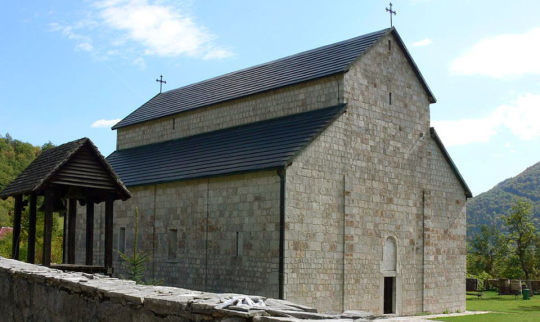
Among the 1600 church sights of the country there are large, small, included in tourist routes, almost forgotten. You are invited to see them on your own or with local excursions. Such a building, called the symbol of invincibility of the inhabitants of the country, is located near Pluzine in the northern part of Montenegro. Among the pine forests near the “Pivsky Oka” in the XVI century there appeared an ordinary house with narrow loopholes that did not attract the attention of the Turks.
Later (after the construction of the hydroelectric power station on the Piva River) the building was moved 2 km higher. In its former place, a guest house (konak), a bakery, a cemetery have been preserved. Here they helped the rebels, sheltered the rebels, held negotiations with representatives of the Christian world. The building is built of stones of gray, pink shades. It has large dimensions: height 13m, length 23, width 15m. The appearance of the building did not cause enemies to rob him.
Inside, there are many old frescoes, a gold-plated iconostasis with a huge cross. A large number of manuscripts, paintings, books, and jewelry are also stored here. One monk lives here permanently. He keeps order, manages the bells, which are not on the roof of the main building, but under the roof of a separate annex. Come to the center of the spiritual life of Herzegovina (now the existing monastery is owned by the Serbian diocese) is proposed by boat on Lake Piva.
Church of the Resurrection of Christ in Podgorica
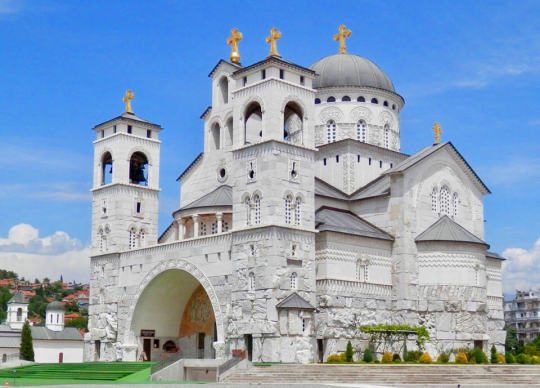
For a long time in the country there was no main church of the Orthodox Church. Since 1993, the first stone was laid in the future huge building, striking in size, splendor of decoration, design. The construction began in the presence of Patriarch Alexy II. The author of the project was architect Pedja Ristic. The building belongs to the Neo-Byzantine style. It included many new architectural elements. The height of the two levels of the cathedral is 41.5 m, the belfry is made of 17 bells (2 brought from Voronezh), 7 crosses sparkling with gilding.
The monumental view of the building is formed by huge blocks of stone, decorated with antique. The interior is characterized by an abundance of images made of small pieces of granite, marble. Mosaic “Noah’s Ark”, a fresco above the entrance measuring 53.5 m 2. In one of the largest temples in Europe at the same time accommodates up to 5 thousand believers.
Daibabe Monastery in Podgorica

At a distance of 4 km from the capital of Montenegro is an amazing place hidden in rocky caves. You can find it by a small building dedicated to the Assumption of the Blessed Virgin Mary with belfries on the sides. The main premises are underground in caves located in the shape of a cross. Local legends say that as early as the III century, the first Christians were hiding in catacombs with their own source of water. The monastery appeared in 1897 and its first rector was the miracle worker Simeon of Daibab (his relics are stored here).
The first liturgy was performed in the cave church in January 1897. The dimensions of the cave used are 20 m in length and about 3 m in width. Chapels are hollowed out on the side walls; an altar is located in the center. The ceiling, the walls were painted by Simeon, his followers. The surviving murals are of great value. In an atmosphere of silence, peace, numerous pilgrims receive relief, hope for a favorable solution to their problems.
Cathedral of St. Tryphon in Kotor
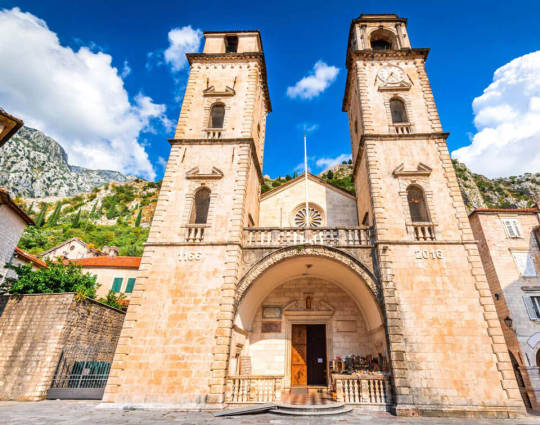
The ancient building is depicted on the coat of arms of the city of Kotor. Saint Tryphon, repeating the path of Jesus Christ, is considered the patron saint of the city. The cathedral in his honor was laid in 1166. Previously, this place was a church, built in 809 by the noble townsman Andrii Saracenis. It was he who bought the relics of St. Tryphon au merchants of Venice.
The devastating earthquake of 1667 required the rebuilding of the bell tower of the cathedral. They are made in the form of high towers (up to 35 m high) made of special stone brought from the island of Korcula. Above the entrance is a window in the shape of the famous “outlet”. The ancient frescoes of the interior are poorly preserved. But even now, under centuries-old layers of stucco, lime on the apse, nave arches fragments of Byzantine-style paintings are revealed.
The exact time, the author of their writing remains the secret of the cathedral. The origin of the rare wooden crucifix in the church is also unknown. The relics of St. Tryphon are considered the main shrine of the Cathedral. In the sarcophagus, standing to the right of the entrance, lies the body of Andria Saracenis. The Cathedral, as a preserved example of the style of Romanesque architecture, is a World Heritage Site.
Church of St. Luke in Kotor
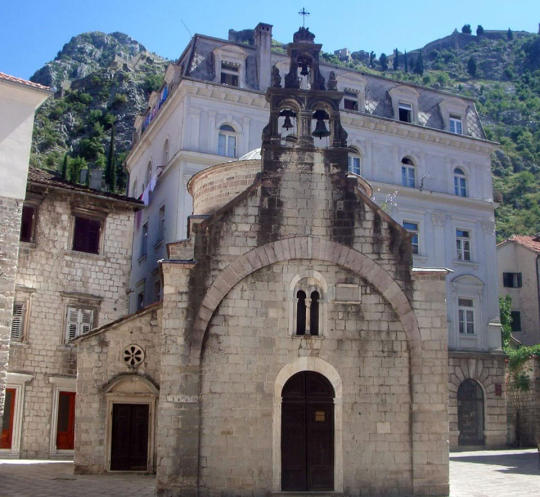
A modest, not conspicuous temple, standing in the historical part of Kotor, is in fact a famous landmark and the oldest church in Montenegro. It was built in 1195 at the expense of the rich feudal lord Kazafragi (a memorial inscription testifies to this). In the current church there are two altars: Catholic and Orthodox), which is rarely found in temples of the world. The two branches of the Christian religion lived here peacefully, in harmony. The main shrines of the cathedral are particles of the relics of St. Luke, the martyrs of Orestes, Mardarius, Auxentius.
Among the interior, fragments of ancient frescoes by Italian, Cretan masters of the 17th and 18th centuries have been preserved. In a small chapel owned by the church, there is a unique iconostasis depicting Christ in the image of the King. The temple opens on holidays, before the planned excursions, weddings, baptisms. An interesting fact is the burial of local residents inside the building. Its entire floor consists of grave gravestones. During the great earthquake of 1979, this church was the only building that was not damaged.
Church of St. Nicholas in Kotor

On Grets Square in the old center of Kotor rises a relatively young Cathedral building, erected in honor of the patron saint of travelers, sailors St. Nicholas. Historically, the existence of a Dominican monastery in this place, turned into a soldier’s barracks for Napoleon’s army, is historically confirmed. After the destruction of the church was built here, life, which broke off the fire of 1896. A new temple was erected on its foundation in 1909.
The building is in line with the pseudo – Byzantine architectural style. At the entrance are two tall belfries. Among the interior decoration stands the iconostasis of three meters high, created in 1908 by Czech artist Ziegler. The treasury of a beautiful building contains many valuable documents, icons, art objects, clothes. The most interesting are the Three-Handed icon, the book “The Sacrifice of Abraham of 1899”, the image of Nicholas the Wonderworker in the form of a mosaic at the entrance. In the courtyard you can use a source of healing water. Services are held daily.
Church on the Island of the Virgin

The history of the creation of the ancient church on the reef, which turned into an island in the original construction way, annually attracts many tourists to the city of Perast. Virgin Mary, living on a reef, protects the local sailors. As a token of gratitude, the locals regularly spend here a feast of fashinada. On decorated boats, they swim around the island three times and throw stones into the water, strengthening the shore.
In such a strange construction way, for almost two centuries, stones were collected on the sunken ships, reefs, a stable platform was formed. It grew an ancient landmark of the country church. The ground floor of the building is decorated with icons, paintings of artists of the 17th century, an organ sounds, whose age is 300 years. The altar is made of four types of valuable snow-white marble and is decorated with the image of the face of the Holy Virgin. It illuminates the interior of the chandelier made of real Murano glass, made almost 3 centuries ago. The archaeological museum is invited to see old exhibits: Roman crosses, a fountain, silver roots.
Drimsim is the first universal sim card for travelers. Internet abroad starts at $ 1 per megabyte, and calls start at $ 3 per minute. Works in 197 countries!
Lifting mechanisms, lights, bells and other elements belonging to ships of different countries at many times. On the second floor are amazing ancient amphoras, jugs, mysterious captain’s chests. A collection of paintings depicting ships, the olive stele of Diva, adorning the bow of a ship in the Middle Ages. Among them is a unique icon of the Holy Virgin, embroidered by a woman from Perast, who had been waiting for 25 years for the return of her sailor husband. Thousands of plates (gold, silver, bronze) are mounted in the walls of the building. They were presented by sailors (the custom still exists) in gratitude to the Virgin for a successful voyage.
Cathedral Church in Bar

A magnificent building was built on the site of the construction of the XVI century in 1863. The last reconstruction was carried out in 2016. The cathedral was consecrated in the name of the first ruler of Montenegro, Jovan Vladimir, who accepted the death of a martyr on the cross. The snow-white architectural creation is decorated with three golden, sparkling domes. They are trophies taken during the Austro-Hungarian occupation in 1918. All bells, guns, cores were remelted and new ones were made. For the past few decades, the cathedral has been the main Orthodox church in the city.
For the manufacture of walls, a beautiful-looking solid stone (red limestone) was used. On the facade there is a window in the form of a “rose outlet”. Inside the cathedral, frescoes with images of Saints have been preserved. The cathedral church is called the largest religious building in Montenegro. Its height is 41 m, an area of 1200 m2. Services are held daily. In a special room of the amphitheater, events are held for cultural and spiritual development of the population.
Gradiste Monastery

In 1116, the construction of Hradiste began on the site of ancient buildings (Grajevine) and the old Greco-Roman cemetery. It became a monument of fresco painting of the Middle Ages in Montenegro. The surviving ensemble includes a cell building, the ruins of a protective wall, a cemetery, and the structures of three churches.
Among them:
Saint Sava. One-nave building of alternating rows of white, red stone and a belfry with three bells. The iconostasis was painted by Nicholas Aspiotis in 1864.
St. Nicholas. Built in the XII century, painted by a fresco master from Budimlya. Among his creations is the fresco “Mammal” (patroness of young mothers). In antiquity, mother’s gifts that did not have breast milk were left next to her. A luxurious carved iconostasis appeared here in 1796.
Assumption of the Blessed Virgin Mary. The small building is located on the upper platform next to the cemetery. The frescoes depict saints from the Nemanich family.
The buildings suffered greatly from destruction during the invasion of the Tatars, the French, during the war of 1941, from a severe earthquake.
Podmaine Monastery in Budva

Historical facts indicate the emergence of a Christian structure at the foot of Mount Ostrog or in a place called Maina, around the time of the reign of the Nemanichi dynasty. For a long period of time here was the residence of the country’s metropolitans. Within its walls, Negosh wrote a literary work, “The Crown of the Mountains,” which became the literary monument of Montenegro. The buildings were given a new life by the modern restoration and opening of the complex in 1995. The complex includes two churches dedicated to the Assumption of the Blessed Virgin Mary.
The large building was renovated in 2000. The icon painter again portrayed the scenes of the Last Judgment, placing among the sinners the image of the communist leader Broz Tito of Yugoslavia. The small church (4 m long and 2.5 m wide) is a catacomb of the first Christians and is located under cells. The building was built in the XII century. A stone water tank is installed in the center. She is famous for amazing stone carving. There is an inscription in the room, indicating that the last restoration took place in 1630.
Dulevo Monastery
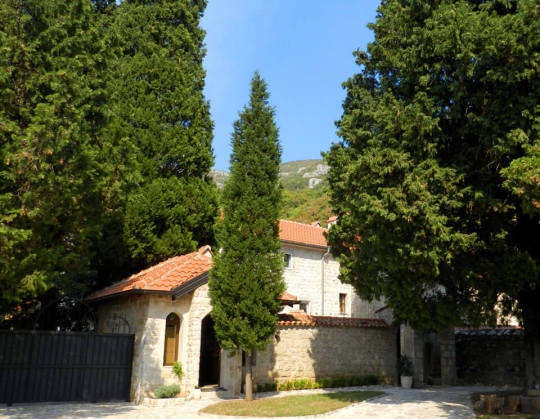
There is a written mention of the structure that appeared in honor of the soldiers of King Dushan in the middle of the XVI century. The novices of the Decana parish came here after a haircut. The building was often destroyed by wars, natural disasters. Now it is fully restored. On the walls of the south and north sides are visible traces of former buildings, a cell building with narrow windows in the form of loopholes, a belfry with a bell. Inside the old building, fragments of two layers of ancient painting, the original frescoes, have been preserved.
They depict scenes from the lives of saints and are a matter of pride. The vault of the room is decorated with compositions covering important gospel events: the Present, Christmas, and the Crucifixion. On it are six medallions depicting Christ, Our Lady of Oranta, and saints. Two cells are located in the upper part of the building (Saint Sava worked in them before traveling to the Holy Mountain).
On the territory there is a source (Savvina Voda), which helps pilgrims treat diseases of the stomach. According to legend, the soldiers of King Dushan were healed of typhoid fever by this water. It is also proposed to see an old oak tree under which Saint Sava sat. The complex is located on a plateau above St. Stephen.
Praskvitsa Monastery
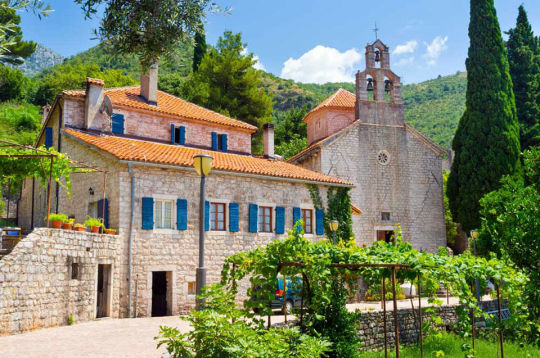
High in the mountains, near the villages of St. Stephen and Pržno, not far from a stream that smells of peaches (where the name of the building came from), an ancient monastic monastery lurks. The religious shrine of Montenegro appeared in 1059. After severe destruction, a new stage in her life began in 1844. The new church of St. Nicholas (the original construction was carried out in 1413), together with the Holy Trinity Church and monastery cells, are included in the architectural ensemble, which is a landmark of the country.
Along with the tour, you can sit at a stone table where the council of elders made crucial decisions of the Middle Ages. Visit the museum with a treasury. It contains a valuable collection of icons, ancient artworks, ancient weapons. Manuscript books (among them the Gospel of the 16th century), documents of the Pashtrovich era, an old monastery seal, the golden cross of Dushan. In the cells there is a valuable library with a total number of books over 5,000 copies.
Rustovo Monastery
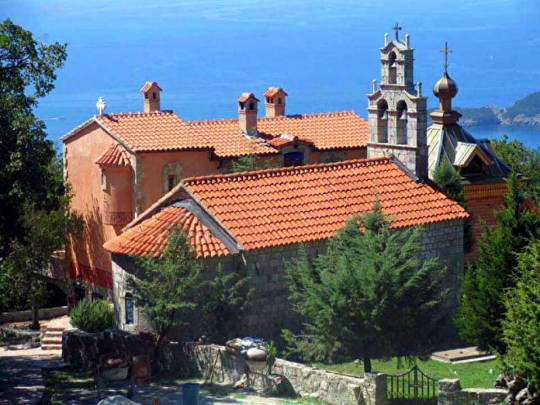
In the current monastery for nuns live 8 sisters. They serve the buildings included in the monastery ensemble. Today it includes the construction of three temples. In 2003, a monastery was founded on the site of the ancient church of the Assumption of the Blessed Virgin Mary (built in the XIV century, destroyed by fires, an earthquake). His consecration took place on the Epiphany Eve. You can still consider the preserved foundation of the ancient structure.
During the construction process, the remains of the pastoral martyrs of the XIV century were found. Archbishop Amphilochius laid the foundation in 20005 for a small cathedral dedicated to members of the Romanov family who were martyred. The remains of the XIV century sufferers were first placed under the altar of a large church, and then buried in the foundation of the Romanov temple.
The third temple (paraclis) is located in the cell building. It is dedicated to the famous saint of the VI century, who founded a large number of temples. Located next to Chelobrodo Hill. It offers a panorama of the most beautiful part of the Adriatic Sea of Montenegro.
Church of the Archangel Michael in Herceg Novi
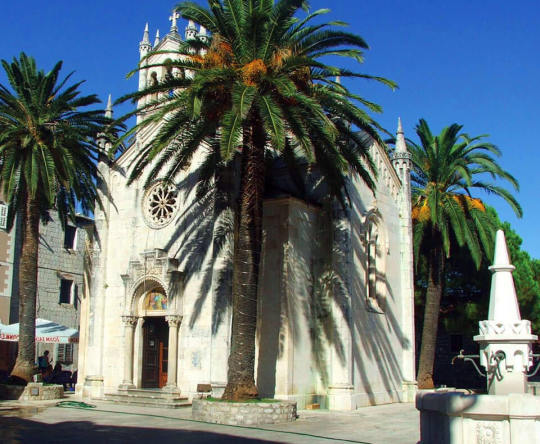
The Orthodox Church, whose age is just over 100 years old, is considered the pearl of the Montenegro region. It stands in the center of the old quarter, on the Stefan Vukmcha square in Herceg Novi. The unusual architectural style is associated with the participation of several architects in its construction. Each of them expressed his preference for the Romanesque, Byzantine, Gothic, Baroque, Islamic architectural heritage. All elements blend in harmoniously and form a unique appearance of the structure.
The interior is striking in its exquisite beauty. The altar and iconostasis were made by master Bilinich from beautiful, rare marble. Many icons are considered rare, unique. They are written by Czech artist Ziegler. The local library holds a large number of church books, including from Russia. The building is surrounded by majestic palm trees. On the beautiful square there are many cozy cafes, places for relaxation, viewing the temple.
Church of the Savior in Herceg Novi

Behind a high stone fence on the main street (Negosheva) is an old temple complex consisting of the churches of the Savior and St. George. The first was built in 1713 from stone blocks brought from the island of Croatia. It received its final appearance in 1864 as a result of a complete restructuring, starting with the foundation. In the middle of the next century, an interesting iconostasis appeared in the building, a belfry with three bells.
Among the many decorations of the interior are several Russian icons. The Church of St. George was built at the end of the 17th century. This place used to be a Turkish mosque. The main shrine is a round icon depicting Saints Peter and Paul. The archives store old books, icons, church dishes made of silver. Behind the fence is an old cemetery, a two-story building of the residence of the bishops of 1700, a school where the future famous poet and priest of Montenegro Negosh studied.
Savina Monastery

The current complex (10 monks live in it), surrounded by a garden with many exotic plants, is the center of Orthodoxy among the settlements along the Boka Kotorska Bay. It is named after the first archbishop of Serbia, St. Sava. The complex includes three buildings: Malaya Uspenskaya, Bolshaya Uspenskaya and St. Sava Church (it is located next to the upper cemetery). The Small Cathedral (10 m long and about 6 m wide) was built in 1039.
The main preserved value is the ancient frescoes made in the Byzantine, Gothic styles. At the end of the 18th century, under the leadership of the Venetian architect Nikola Foretic, the Great Temple was built in the style of luxurious baroque. The iconostasis of the 18th century, consisting of separate zones created in the traditions of the Orthodox style of the east, has been preserved.
Sacred relics are considered to be a crystal cross belonging to Savva and decorated with rubies, the relics of Tsarina Helena, George the Victorious, the shroud of 1642. Icon collection, library containing over 5,000 rare manuscripts, handwritten gospel. The church of St. Sava was built by him in the 1230s. Now it is used as the parish church of the monastery.
Banya Monastery in Risan

The existing convent, founded in the 15th century, is located on the shore of the Gulf of Risan. In ancient times, there were Roman baths, which gave the name to the new building. In the XVII century, a temple was erected on the foundation of an ancient medieval fortress in honor of St. George the Victorious. Particles of the relics of the great martyr are the main shrine. The existing look was created during the restoration in 1729, carried out at the expense of wealthy sailors of the region.
Now here you can see old icons, clothes used during religious rituals. It is skillfully embroidered with silver, gold threads, decorated with gems. Many faces of saints are made using the techniques of ancient embroidery. The library archive contains a large amount of church literature. It is allowed to visit the interior with a guided tour, groups of pilgrims when performing the prescribed form of clothing and observing all the rules.
#Banya Monastery in Risan#Cathedral Church in Bar#Cathedral of St. Tryphon in Kotor#Cetinje Monastery#Church of St. Luke in Kotor#Church of St. Nicholas in Kotor#Church of the Archangel Michael in Herceg Novi#Church of the Resurrection of Christ in Podgorica#Church of the Savior in Herceg Novi#Church on the Island of the Virgin#Daibabe Monastery in Podgorica#Dulevo Monastery#Gradiste Monastery#Moraca Monastery#Ostrog Monastery#Piva Monastery#Podmaine Monastery in Budva#Praskvitsa Monastery#Rustovo Monastery#Savina Monastery
0 notes
Photo

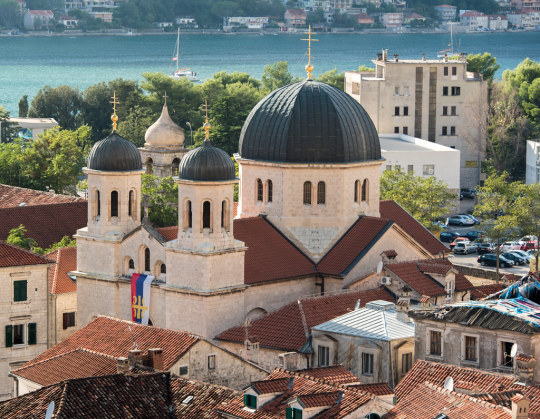
St Nicholas Church, Kotor, Montenegro
#kotor#montenegro#balkans#adriatic sea#photoset#architecture#church#cathedral#skyline#southern europe#europe#travel#travel blog#europe travel#vertical
647 notes
·
View notes
Photo

St Nicholas Church, Kotor, Montenegro / http://picstreet.fr
1 note
·
View note
Photo

Church of St Nicholas by AnatolyBerman // Kotor, Montenegro
1 note
·
View note
Text
Kotor Old Town: 1350 Steps to The Crown

Kotor Old Town is rising star of Montenegro. For a few years, Kotor became more and more people among the traveller. Kotor is a very small city with only 13510 residents. City is located at the Gulf of Kotor and more popular than the capital of Montenegro, Podgorica. Kotor Old town is surrounded by fortifications built by the Republic of Venice. History of the town dates back to the Roman era. In this post, you will discover this fascinating city of one of the youngest countries in the world.

Panoramic view of the Bay of Kotor from the Kotor Fortress (Source).
History of Kotor
Early History of Kotor
Kotor has a long-standing and complex history and maybe the most fascinating one when compared to the other major tourist spots. Name of the Kotor first appeared in the Roman artefacts. Those times (168 BC) the city is known as Acruvium, Ascrivium or Ascruvium and was the part of the Dalmatia. Kotor always fortified by its conquerors because of the geostrategic location of the settlement. Around 535 Emperor Justinian built a fortress over the town (Ascrivium) after the expelling the Ostrogoths. After a quite long time from the Emperor Justinian Kotor was plundered by the Saracens in 840 and fortified more and more toward to the peak of Saint Ivan by the Constantine VII Porphyrogennetos in the 10th century. Between 1002 and 1143 Kotor was under influence of the First Bulgarian Empire.
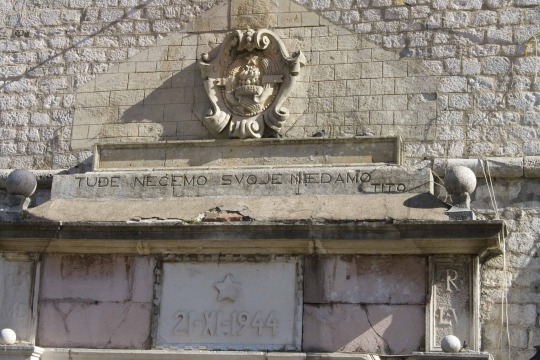
The entrance of old town Kotor with post-World War II sign "What belongs to others we don't want, ours we don't give" (Source).
Venice, Ottoman Rule and Modern Times
Kotor conquered by the Grand Principality of Serbian in 1185 and Serbs ruled the city until the year of 1391. After the death of Tvrtko (King of Bosnia) in 1391, Kotor became fully independent until the threat of conquered by the Ottomans. Kotor asked for help from Venice when the Ottoman threat rose up. The city was part of Venetian Albania between 1420 to 1797. In this time frame Ottomans besieged the city two times, 1538 and 1657. More than 4 century Venice made great contribution to the Kotor's current heritage. During these 4 centries city was own time-to-time by the Ottomans also.

You will get lost the fascinating streets of Old Town (Source).
After the Treaty of Campo Fomio in 1797, Kotor passed to the Habsburg Monarch but in 1805 became part of the French Empire's client state. Even Russian held the city for a while but in 1810 the city return to the Kingdom of Italy. Kotor became one of the main bases of the Austro-Hungarian Navy and home of the Austrian Fifth Fleet. After the end of World War I (The Great War), Yugoslavia founded an the city became part of it. Kotor got it name from that date. During the tensions of World War II, Kotor annexed by Italy and stayed that way between 1941 and 1943. It is complicated, right? Kotor has a stunning heritage because of its historical heritage.
Where is Kotor Old Town?
Kotor is only 85 km away from the Podgorica, capital of the Kotor. If you want to go to the Kotor Old Town by plane you should go to Podgorica Airport. The nearest airport to the Kotor is the Tivat Airport but it will hard to find a flight to there. It is also possible to go to the Kotor Old Town by renting a car from nearest major cities like Tiran, Pristine or Skopje.
How to Go to Kotor Old Town?
Unfortunately, there is no train to the Kotor from any city because of the channelling geography of the area. You should rent a car, taxi or buy a ticket for the buses. Don't worry buses are good to travel and trusted. You should find the bus routes to the Kotor Old Town from other cities.
Podgorica to Kotor: 14 - 20 Euro
Tiran to Kotor: 13 - 19 Euro
Belgrade to Kotor: 19 - 40 Euro
Skopje to Kotor: 24 - 35 Euro
Budva to Kotor: 11 - 17 Euro
Kotor Old Town and Fortress
When you enter the gate of the Kotor Old Town you will start time travel through history. Kotor Old Town have multiple historical places to see during your time there. At the main entrance of the Kotor Old Town, you will a couple of places to drink coffee or eat a pizza with shops and other places. Before starting to move up to the top I'm strongly suggesting to walk around the street for a while. You need to heat your leg, you will need it :) Gate of the Kotor Old Town opens at 08.00 am in the morning. If you go to the Kotor during summer you will think to go to the top early hours in the morning or evening to avoid the excessive heat.
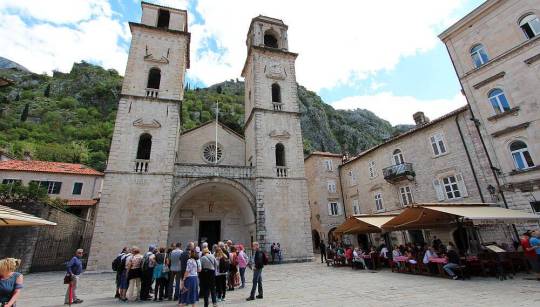
The main entrance of the Kotor Old Town (Source).
There is no tickets or price to enter the Kotor Old Town. Also, you don't need a guide to visit the town. There are multiple apps or maps for the Kotor Old Town. You will also find maps at the entrance. In this link, you will a really good map and information about the trail to the top. There are three entrances to the old town; South Gurdic Gate, Main Sea Gate and North River Gate. You will probably use the Sea Gate to enter. Before you start to walk to the top you may want to visit some important spots in the town. You will find the list (a long list) of them below;
Riva Bastion
Campana Tower
Citadella
Valier Bastion
Corner Bastion
Gurdic Bastion
St. Tryphon's Cathedral
St. Nicholas Church
St. Lucas Church
St. Mary's (Blessed Ozana)
St. Paul's Church
Santa Anna's Church
St. Michael's Church
St. Josep's Chruch
St. Francis Monastery
Santa Clara's Monastery
Arms Square
Flour Square
Karampana Square
Town Tower Clock
Prince's Palace
Old Town Hall
Venetian Arsenal
Town Hall
Historical Archives
Venetian Barracks
Austrian Prison
Drago Palace
Grgurina Palace
Pima Palace
Macchin House
Lombardic Palace

The clock tower of the Kotor Old Town (Source).
Time to Start to Walk
If you spend time for a while in the Kotor Old Town you will start to walk to the top. There will an 8 Euro entrance fee to the trail road to the top. There is around 1350 step that you have to climb. Don't worry there are multiple places to rest while climbing. There are 3 different routes for the trail to the top and down. There are two important place in this trail, Lady of Remedy Chruch and St. John's Castle. It will be easy to reach the church but the castle will be a little tiring for you. If you're confident don't use the red route to go down. Because on some part of it there are no stairs or road to follow. You just need to jump over the wall or make your own way through the trees.

The red route would be really challenging (Source).
Lady of Remedy Chruch
The year 1435 was a sad page of the history of Kotor. Plague during the year wiped out most of the population of the Kotor Old Town. People of Kotor built the Lady of Remedy Church to have God's protection over them. Your first aim should be reached to the Lady of Remedy Chruch. After around 500 steps you will reach the church. It is not a big but beautiful one. Lady of Remedy Chruch was built during the 15th century. The church has a baroque style with a gothic arch. Three bells of the church are quite famous because they made in the bell foundry De Poli in Vittorio Veneto, Italy. You will see a crypt inside the church. That crypt is related to Bolic family of Kotor. There is also the tomb of count Anton Lukovic (Kotor citizen) outside of the church.

You will rest and enjoy the view for a while (Source).
St. John's Castle
You need to climb around 800 steps more to reach the St. John's Castle from the Lady of Remedy Chruch. St. John's Castle is located 260 meters high from the sea level. Unfortunately, St. John's Castle is a crumbled ruin but it is still possible to climb over it and enjoy the view through the Kotor Old Town and stunning nature of the region. There is a plan for the restoration of the castle, pathways, sightseeing spot and other thing but it didn't start yet.
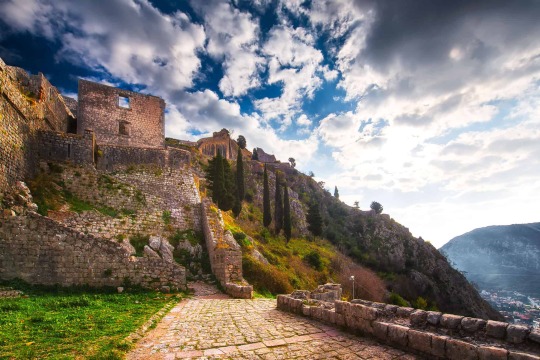
Ruins of the St. Jonh's Castle (Source).
Suggestions for Visiting Kotor Old Town
It better starts early to climb up.
Take a couple of bottle of water. You won't find anywhere to buy during the trail. Maybe there will be some people who will be selling it but not for sure.
Climbing will take around 2 hours, be prepared for that.
Don't forget to wear suitable clothes and especially shoes.
Enjoy the view!
If you ever visited or thinking to visit the Kotor Old Town please share your experiences and questions on the comment section to help others.
Read the full article
0 notes
Photo
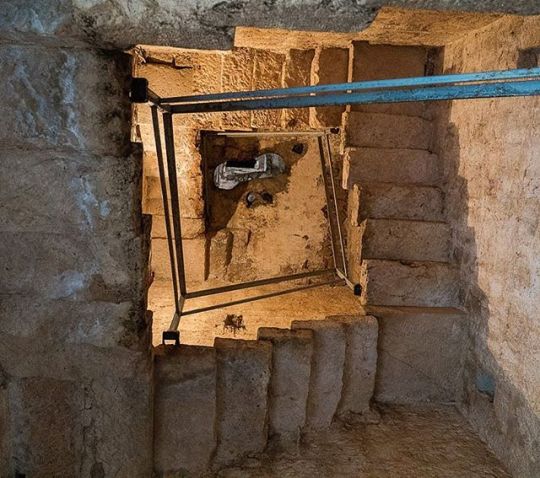
Climb the 150 steps of the Sveti Nikola Church bell tower and you'll get some of the most sensational views of Perast and the Bay of Kotor. St. Nicholas Church, is a Catholic church that dates back to 1691 and is located in the main square of Perast. The bell tower is 55m long and you can go up for €1. 🚶 Join the journey @travelmvmt ________________________________ #svetinikola #stnicholas #Montenegro #crnagora🇲🇪 #perast #perastmontenegro #travellocal #localtravel #perasttown #instamontenegro #gomontenegro #montenegrowildbeauty #beautifulbalkans #sharemontenegro #natgeobalkan #montenegroinsider #montenegrotravel #visitmontenegro #tourismmontenegro #montenegro🇲🇪 #belltower — view on Instagram https://ift.tt/354FrZM
0 notes
Text
Kotor is considered as one of Europe’s perfect getaway destinations, largely due to its breathtaking mountains, its tranquil, winding rivers, and its impossibly beautiful coastlines. It’s the photographer’s paradise, since every turn is a picture-worthy vista. It’s also a place popular to cruise ships including ours craving to experience our slice of paradise.
But what’s truly European about such a landscape? Surely mountains and coastlines, just as beautiful or even more so, can be found in other parts of the world. Well, when one thinks of Europe, one certainly visualizes its rich history embedded within the remains of medieval walls and structures. In this front, Montenegro does not disappoint.
Nestled along a coastline, much like Dubrovnik, is a living remnant of times past. Just as perfectly preserved as Croatia’s capital was Kotor — Montenegro’s Old Town and a thriving part of the country’s history.
The reddish roof of the buildings was unmistakeable as we made our way into the port. Like we did before, we docked right into the Old Town and disembarked. Here I began a DIY tour that led me to appreciate this little-known city in Southeast Europe.
The Main Square
Passing through the town’s Main Gates, I arrived at the main square — the Piazza of the Arms, which was (and still is) the main site of gatherings in the town. As Kotor strives to cater to tourists, the area is laden with cafes, restaurants, and shops. Aside from this, it’s also surrounded on all sides by palaces! These date back to the 18th and 17th centuries.
On one side is the old theater and town hall, which is now the Hotel Cattaro. There’s also a Clock Tower that dates back to the early 1600s, and Rector’s Palace. This abundance of living artifacts justifies Kotor’s place as a UNESCO World Heritage Site.
One of the more interesting structures around here is a pyramidal structure standing at the base of the Clock Tower. Called the Pyramid of Shame, it was used for torture and punishment in the Middle Ages. You can’t feel the horror as you step in today, what with the touristy atmosphere, but at one time this was the most repulsed part of the town!
The Walls of Kotor
Like any other European Old Town, one of the most distinct characteristics of Kotor is its impressive network of fortifications. Rows of walls, many still intact, are punctuated by towers, gates, and citadels. There is also a castle and surrounding buildings. Some of these, like Castle St. John, had been in existence since the 6th century. Some others are the fruits of painstaking preservation and restoration efforts, especially since a good part of the fortifications were damaged by a huge earthquake in 1969.
When you set foot in Kotor, it’s impossible not to notice the rustic beauty of these structures. Following the upward slope of the landscape, the walls are silhouetted against the sky. And if you’re not content to be at the bottom looking up, you can make your way up the ramparts for a stunning view of the town. It’s one of those times when man’s creations only serve to enhance the beauty of the nature around it!
Palaces and Churches
The town’s palaces are not just those located around the main square — they pepper the city, giving an insight to the relative affluence of Montenegro since the Middle Ages.
There is, for example, the Prince’s Palace and the Baroque-style Maritime Museum which was once the Grgurina Palace. There is also the Buća Palace, belonging to the influential Buca family. The Gothic structure was originally built in the 14th century, but was reconstructed into a far more modest-looking structure in the 1600s after an earthquake damaged the original. The only remnant of the original structure is a window on the western side that can be only seen from the walls.
Across Buća is the Pima Palace, which completely eclipsed its neighbor in beauty. It was built from dust as the Buća was being renovated, and its Renaissance-Baroque structure is a must-see. It still bears the coat of arms of the Pima family for whom it was named.
St. Nicholas
St. Luke’s Church
And just like in Dubrovnik, if you really want to see elaborate architecture in this Old Town you should best head for the churches. I visited the little St. Luke’s Church, whose petite structure belies a rich religious history. Constructed by Catholics before the 1200s, it held two altars from the late 1600s to the beginning of the 1800s: one Catholic, and one Orthodox. Each faith took turns in using the church for its services! Sadly, this custom came to end.
Much more recent is the building of St. Nicholas Church, whose present incarnation was completed only in the 20th century. The original one fell after a fire consumed it years before. This is currently the largest church in Kotor, and contains a mini-museum of artifacts, books, documents, and ancient items.
One Last Look
Our Lady of the Rock and St. George islands
Kotor is a fairly small town, and in no time I had covered a lot of the must-see places. Pretty soon, it was again time to board the ship. But the sightseeing was not yet over. As we sailed off Kotor, captain decided to give us a little treat before heading out to the open sea. The ship rounded two small islands adjacent to each other. These were the Our Lady of the Rock and St. George islands!
St. George island
Located in the mesmerizing Bay of Kotor, the first island contains a museum and a church. What’s really remarkable about it is that it’s an artificial island, made by sinking ships and rocks. St. George, on the other hand, contains a monastery and served as the graveyard for the region��s old nobility. While we did not get to land in either of the islets, we did get a good 360-degree view of them!
Our Lady of the Rock
Montenegro is a really invigorating place, and the type where you won’t get tired even if you spend the whole day walking around its sights. Maybe it’s the refreshing backdrop of nature, or the laidback setting of the medieval city. Maybe it’s the vibrant history surrounding the place, or the passionate culture of the locals. Whatever it is, Kotor is something that’s worth your visit any time of the year!
The Countless Treasures of Kotor Kotor is considered as one of Europe's perfect getaway destinations, largely due to its breathtaking mountains, its tranquil, winding rivers, and its impossibly beautiful coastlines.
0 notes
Text
Tolerated Through The Castle City: Kotor - #BestPizza, #EuropeanCities, #Italy, #Kotor, #Museum, #OttomanCity, #ProntoPizzeria
New Post has been published on http://justforustravel.com/2017/10/11/tolerated-through-the-castle-city-kotor/
Tolerated Through The Castle City: Kotor
from time to time, “would you like to live in which era?” we became being forced to give an answer to the question. If you are interested in history this could be the subject of raki’s Supper. Medieval’s dan once giving up I don’t remember. During the Renaissance, the castles of the period, political games, trading and wars… the diversity of life within the castle, and individuals that would make you feel safe within the walls of the Middle Ages, a term that sums up why yourself. In that period the castle we can see the importance of the rare places that still Kotor at the moment…
how is conquered in here?
Kotor is one of the most interesting geographic structure of European cities. Although landlocked fjords on the vehicle due to bumpy roads to get to the old Ottoman city. The history of geographical structure so much that it changed the course of the war very much read, we’ve heard. Not too much unlike the structure of the state in every country except the Ottoman city walls and inside the castle that leads to the engine’s also the only thing on your mind throughout the trip: “how is it conquered?”?
“I feel safe inside the castle Myself,”
situated within the walls of the city captured from the sea almost up to the sky, it’s not much of anything outside of the castle. Of course, you can enter the sea in summer, especially if you’ve been in the surrounding regions. But the castle within the heart of the city beats. You may feel yourself insecure to work it out from the inside of the castle. Very normal! Belong you to the castle.
arbitrary a bargain at the museum
Kotor, the country’s most popular tourist attraction in the city, did not forget to provide good facilities for travelers. See all the historical buildings inside the castle again by reminding you that I can tell; museum/exhibition/Church, such as the little signs on all structures have been considered great in terms of showing you where you are. Thank you Kotor, it’s beautiful, my dear. The biggest secret of TO in the next sentence you will read this summer. You may not believe me, but interesting Maritime Museum, which is one of the museums’s the price we are given post, “we don’t” the curator when we say bargain offered. Only Kotor in my life that’s I lived. :))
Yay Turkish map
often when you arrive to a new city, Travel tourist information first thing’s a mid-city map. At the same time, I can say that it is a good collection. Montenegro’s Turkey for a long time’s den visa will be increased the number of Turkish tourists in the region that doesn’t want tourist information, so that’s also here you can find the Turkish version of the show.
Sorry, there is a italian you?
Actually, it’s a classic. If you are in a city that is located by the sea, seafood is not to eat your first choice. Kotor, Venice’s and Italy under the rule’s because it is close to in the kitchen in this country has been affected. Seafood risotto, octopus and the most preferred food types pizza in the area. Kotor’s when you ask where the best pizza place is, follow the smell you get answer Pronto Pizzeria. It was pretty big and the variety is pretty much the pizzas on the menu also. Average price is 6-7 euro.
cheap alcohol disrupts the structure of
we drink cheap beer with Belgrade, Kotor is one of the cities most trips. To say beer is better, but it’s 1.5 euros a bottle for 50’lik, it is possible to drink beer. Hostel Old Town Kotor for the evening’s pub crawl-dan’s A you can join. If you are early, St. Mary’s Collegiate Church, the Saint Nicholas Church in time between the Ottoman and probably played cards, coffee looking “bar” you can sit down.
“Peyniiiiiiirrrrrrr”
while the popularity of selfie craze is not on the agenda two years ago continues.Give up one of our spirit is contrary to the imperatives of the trip. Every Japanese’s French’s Brazil’s selfie in a bar if you have hands, of course we have. Kotor’s views don’t miss.
0 notes
Text
5 Must Do Things in Kotor Montenegro

Kotor Montenegró is arguably one of Europe’s hidden gems. This picturesque town nestled at the foot of Mt. Lovcen is the end point of the Bay of Kotor. It is a fairly new port of call for cruise ships sailing the Adriatic Coast.
Montenegró is a new country having gained her independence in May 2006. It’s tourist industry is just getting off the ground which is great for us tourists. We were quite surprised to find everything in town very inexpensive.
Kotor, Montenegró although new to the tourist scene is steeped in history. First settled by the ancient Romans, Kotor was founded as early as the 5th. Century B.C. It was later fortified by Emperor Justinian in the Byzantine era.
Kotor has deep maritime roots. Hailed as the center of sailing since the 12th. Century with a rich naval history Kotor helped build the communities along the country’s Adriatic coast.
In short there are many things to see and do in and around Kotor Montenegró. Here are my 5 favorite things to do in Kotor.
1. Explore the Old Town a UNESCO World Heritage site. Wander the maze of cobblestone streets lined with simple buildings topped with sepia colored roofs, Romanesque churches, and quaint shops and cafés. In the Old Town you’ll find St. Triphon’s Cathedral built in 1166, the Church of St. Nicholas built in 1909, as well as other churches, monasteries, palaces, and museums.
You’ll also find the entrance to the fortification that runs up the mountain and protected the city in ancient times. While in the Old Town you might be lucky enough to catch a performance of Montenegrin fold dancers. They preform in the square right in front of the main gate into town. Old Town is filled with small squares and alleys where you’ll find restaurants and cafés. Grab a table and enjoy a glass of wine or better yet a meal. Kotor is known for great fresh seafood.
Take a cruise along Boka Bay. Boka Kotorska or Boka (Kotor) Bay is one of the most indented portions of the Adriatic Seas. Although it is widely known as Europe’s southern most fjord it’s actually a submerged river canyon. Picturesque towns line the coasts of the bay as it meanders from the entrance from the Adriatic to its end in Kotor. You can hop on one of the tourist boats that ply the day all day long, or hire a private boat. Which ever way you choose this scenic boat ride is a definite must!
Visit the Our Lady of the Rocks Island. The church is located in Boka Bay on a man made island of the same name. It is one of the 2 islands in the bay, the other is St. George. Legend has it that the islet was built over the centuries by local seamen who kept an ancient oath after finding the icon of Madonna and Child on the rock in the sea on July 22, 1452. When the seamen returned from each successful voyage, they laid a rock in the Bay. Over time the island was built. The custom of throwing rocks into the sea is alive even nowadays. Every year on the sunset of July 22, an event called fašinada in the local dialect, when local residents take their boats and throw rocks into the sea, widening the surface of the island, takes place.
2. The islet is home to Our Lady of the Rocks Catholic church which houses a museum. The church display 68 paintings by Tripo Kokolja, a famous 17th-century baroque artist from Perast and a collection of silver votives and paintings by other Italian artists. The museum displays many artifacts, paintings, and tapestries.
The most famous tapestry was embroidered by Jacinta Kuni?-Mijovi? from Perast. She embroidered the tapestry while waiting for her husband to return from a long sea voyage. She used gold and silver thread as well as her own hair. It took her 25 years to finish this intricate tapestry; you can see the hair she used turn from blond to white.
Visit the town of Perast. Perast is a well preserved Baroque city on Boka Bay. It flourished in the 1700’s due to its busy shipyards. It is one of the loveliest towns on Boka Bay. Its narrow streets and Baroque palaces reflect its inhabitants wealth and luxurious lifestyle in days gone by. Try the fried stuffed olives, they’re delightful!
Take a drive to Budva. Budva is a fortified city on the Adriatic coast. It’s 2500 years old making it one of the oldest towns along this coast. Today it’s know for its Old Town as well as its sandy beaches and night clubs some of which are located just outside the town’s ancient walls. Budva is a center of Montenegrin tourism and is known as Budva Riviera. It is known has having some of the best beaches on the Adriatic coast and stretches out from the city.
Unlike Kotor, Budva has a more modern feel. Historical sites are contained within the walled Old Town. The surrounding areas are sprouting with new hotels, condos, shops, restaurants, and bars. Located on a wide swatch of sand is Jaz Beach. It serves as a venue for concerts and festivals. While in Budva do sit down at one of the restaurants and try an order of Palacinke. The Montenegrin version of pancakes or crepes. They can be either sweet or savory filled with anything from jam to ham, cheese, veggies, and even tuna.
In Kotor itself there is a public bus that services the town and the coastal villages around the coast. Tourist can choose to take the hop on – hop off bus that runs all day from Kotor to Risan with stops in Perast and Bajova Kula. Tickets cost €20 and includes tickets for the Roman Mosaics in the town of Risan, tickets for the Museum of Old Town Perast, and a guided walking tour of Kotor’s Old Town.
But since most everything around Kotor centers around the bay the easiest way to get around is by boat. You can take one of the boat tours sold around town or hire a private boat and explore the bay at your leisure.
Ready to plan your trip to Kotor Montenegro? Let Savvy Nana Travel help you plan your dream vacation! I specialize in cruises and custom itineraries, what ever your interest and your budget I’m sure I can help you plan the perfect vacation.
0 notes
Text
Kotor Old Town: 1350 Steps to The Crown

Kotor Old Town is rising star of Montenegro. For a few years, Kotor became more and more people among the traveller. Kotor is a very small city with only 13510 residents. City is located at the Gulf of Kotor and more popular than the capital of Montenegro, Podgorica. Kotor Old town is surrounded by fortifications built by the Republic of Venice. History of the town dates back to the Roman era. In this post, you will discover this fascinating city of one of the youngest countries in the world.

Panoramic view of the Bay of Kotor from the Kotor Fortress (Source).
History of Kotor
Early History of Kotor
Kotor has a long-standing and complex history and maybe the most fascinating one when compared to the other major tourist spots. Name of the Kotor first appeared in the Roman artefacts. Those times (168 BC) the city is known as Acruvium, Ascrivium or Ascruvium and was the part of the Dalmatia. Kotor always fortified by its conquerors because of the geostrategic location of the settlement. Around 535 Emperor Justinian built a fortress over the town (Ascrivium) after the expelling the Ostrogoths. After a quite long time from the Emperor Justinian Kotor was plundered by the Saracens in 840 and fortified more and more toward to the peak of Saint Ivan by the Constantine VII Porphyrogennetos in the 10th century. Between 1002 and 1143 Kotor was under influence of the First Bulgarian Empire.

The entrance of old town Kotor with post-World War II sign "What belongs to others we don't want, ours we don't give" (Source).
Venice, Ottoman Rule and Modern Times
Kotor conquered by the Grand Principality of Serbian in 1185 and Serbs ruled the city until the year of 1391. After the death of Tvrtko (King of Bosnia) in 1391, Kotor became fully independent until the threat of conquered by the Ottomans. Kotor asked for help from Venice when the Ottoman threat rose up. The city was part of Venetian Albania between 1420 to 1797. In this time frame Ottomans besieged the city two times, 1538 and 1657. More than 4 century Venice made great contribution to the Kotor's current heritage. During these 4 centries city was own time-to-time by the Ottomans also.

You will get lost the fascinating streets of Old Town (Source).
After the Treaty of Campo Fomio in 1797, Kotor passed to the Habsburg Monarch but in 1805 became part of the French Empire's client state. Even Russian held the city for a while but in 1810 the city return to the Kingdom of Italy. Kotor became one of the main bases of the Austro-Hungarian Navy and home of the Austrian Fifth Fleet. After the end of World War I (The Great War), Yugoslavia founded an the city became part of it. Kotor got it name from that date. During the tensions of World War II, Kotor annexed by Italy and stayed that way between 1941 and 1943. It is complicated, right? Kotor has a stunning heritage because of its historical heritage.
Where is Kotor Old Town?
Kotor is only 85 km away from the Podgorica, capital of the Kotor. If you want to go to the Kotor Old Town by plane you should go to Podgorica Airport. The nearest airport to the Kotor is the Tivat Airport but it will hard to find a flight to there. It is also possible to go to the Kotor Old Town by renting a car from nearest major cities like Tiran, Pristine or Skopje.
How to Go to Kotor Old Town?
Unfortunately, there is no train to the Kotor from any city because of the channelling geography of the area. You should rent a car, taxi or buy a ticket for the buses. Don't worry buses are good to travel and trusted. You should find the bus routes to the Kotor Old Town from other cities.
Podgorica to Kotor: 14 - 20 Euro
Tiran to Kotor: 13 - 19 Euro
Belgrade to Kotor: 19 - 40 Euro
Skopje to Kotor: 24 - 35 Euro
Budva to Kotor: 11 - 17 Euro
Kotor Old Town and Fortress
When you enter the gate of the Kotor Old Town you will start time travel through history. Kotor Old Town have multiple historical places to see during your time there. At the main entrance of the Kotor Old Town, you will a couple of places to drink coffee or eat a pizza with shops and other places. Before starting to move up to the top I'm strongly suggesting to walk around the street for a while. You need to heat your leg, you will need it :) Gate of the Kotor Old Town opens at 08.00 am in the morning. If you go to the Kotor during summer you will think to go to the top early hours in the morning or evening to avoid the excessive heat.

The main entrance of the Kotor Old Town (Source).
There is no tickets or price to enter the Kotor Old Town. Also, you don't need a guide to visit the town. There are multiple apps or maps for the Kotor Old Town. You will also find maps at the entrance. In this link, you will a really good map and information about the trail to the top. There are three entrances to the old town; South Gurdic Gate, Main Sea Gate and North River Gate. You will probably use the Sea Gate to enter. Before you start to walk to the top you may want to visit some important spots in the town. You will find the list (a long list) of them below;
Riva Bastion
Campana Tower
Citadella
Valier Bastion
Corner Bastion
Gurdic Bastion
St. Tryphon's Cathedral
St. Nicholas Church
St. Lucas Church
St. Mary's (Blessed Ozana)
St. Paul's Church
Santa Anna's Church
St. Michael's Church
St. Josep's Chruch
St. Francis Monastery
Santa Clara's Monastery
Arms Square
Flour Square
Karampana Square
Town Tower Clock
Prince's Palace
Old Town Hall
Venetian Arsenal
Town Hall
Historical Archives
Venetian Barracks
Austrian Prison
Drago Palace
Grgurina Palace
Pima Palace
Macchin House
Lombardic Palace

The clock tower of the Kotor Old Town (Source).
Time to Start to Walk
If you spend for a while in the Kotor Old Town you will start to walk to the top. There will an 8 Euro entrance fee to the trail road to the top. There is around 1350 step that you have to climb. Don't worry there are multiple places to rest while climbing. There are 3 different routes for the trail to the top and down. There are two important place in this trail, Lady of Remedy Chruch and St. John's Castle. It will be easy to reach the church but the castle will be a little tiring for you. If you're confident don't use the red route to go down. Because on some part of it there are no stairs or road to follow. You just need to jump over the wall or make your own way through the trees.

The red route would be really challenging (Source).
Lady of Remedy Chruch
The year 1435 was a sad page of the history of Kotor. Plague during the year wiped out most of the population of the Kotor Old Town. People of Kotor built the Lady of Remedy Church to have God's protection over them. Your first aim should be reached to the Lady of Remedy Chruch. After around 500 steps you will reach the church. It is not a big but beautiful one. Lady of Remedy Chruch was built during the 15th century. The church has a baroque style with a gothic arch. Three bells of the church are quite famous because they made in the bell foundry De Poli in Vittorio Veneto, Italy. You will see a crypt inside the church. That crypt is related to Bolic family of Kotor. There is also the tomb of count Anton Lukovic (Kotor citizen) outside of the church.
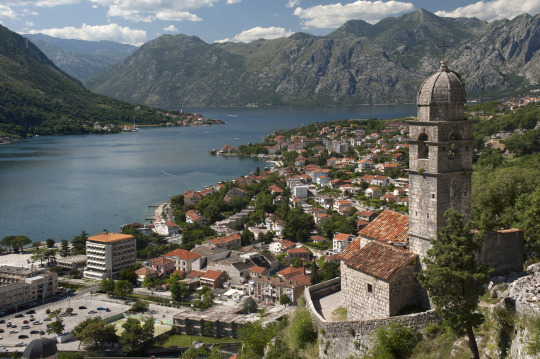
You will rest and enjoy the view for a while (Source).
St. John's Castle
You need to climb around 800 steps more to reach the St. John's Castle from the Lady of Remedy Chruch. St. John's Castle is located 260 meters high from the sea level. Unfortunately, St. John's Castle is a crumbled ruin but it is still possible to climb over it and enjoy the view through the Kotor Old Town and stunning nature of the region. There is a plan for the restoration of the castle, pathways, sightseeing spot and other thing but it didn't start yet.

Ruins of the St. Jonh's Castle (Source).
Suggestions for Visiting Kotor Old Town
It better starts early to climb up.
Take a couple of bottle of water. You won't find anywhere to buy during the trail. Maybe there will be some people who will be selling it but not for sure.
Climbing will take around 2 hours, be prepared for that.
Don't forget to wear suitable clothes and especially shoes.
Enjoy the view!
If you ever visited or thinking to visit the Kotor Old Town please share your experiences and questions on the comment section to help others.
Read the full article
0 notes